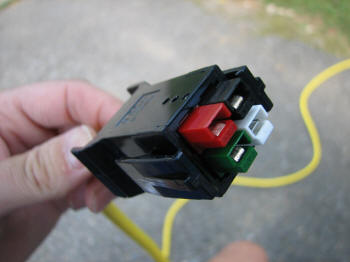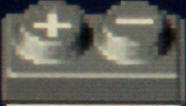 |
Charlie's PriUPS
UPDATE 01 July 2012
Charlie was kind enough to send an update in the midst of a serious power failure and heat wave. "Derecho" was a new word for me and hopefully will remain an obscure one given the large-area consequences. At least Charlie's ice cream is safe.
Original entry from 2006: Although Charlie used the same major hardware components I did, his implementation differs, and he ran into a few complications that I didn't. He also is clearly a safety-conscious dude! Read his valuable comments on DC fusing, which is more critical than AC. And he has his priorities straightĖone of his main goals is to make sure the ice cream doesn't melt.
Among the differences
- He found that the UPS would drop out on surge loads. That was resolved by the addition of some capacitors as described below.
- I commented that I felt the 12/3 extension cord was a little light given its length. Charlie: "I thought about going heavier than 12/3, but (1) for the draws I was expecting the math said it ought to be ok, (2) if I was really drawing much more than 12/3 could handle I'd want my fuse to blow first, and (3) it's heavy enough to lift as it is -- that length of 10/3 would have been much too heavy for my wife to lift. This may indeed be a factor in the issues I experienced keeping up with surge loads on the Cherokees."
- The relay terminals on his 2006 Prius aren't fully threaded as they are on my 2005. See the photos below.
- I left my R3000XR with it's large and long factory power cord attached. Charlie's (better) solution was to remove it to save weight and use a light cord, since the only current it will need to carry is that required for a restart. I should probably do this, too.
Charlie comments on the purpose and ultimate success of the project:
"Lastly, it might be worth saying why I chose the solution I did. My goal was to have a reliable, quiet, long-running power source to back up my rather unreliable neighborhood power circuit. I wanted to keep my fridge and my furnace fan going during extended outages; interruptions that don't melt the ice cream or make my house really cold in winter are ok. (Ok, it would be great if I could power the central a/c too, but that just doesn't seem all that likely.) I decided to mount the UPS in the house instead of in the car because (1) I hate lifting heavy stuff even in good weather with the lights on, and (2) I have a long distance from where I park to where my load center is and I preferred to push fewer amps through that long cord. I used a mechanical transfer switch even though I could have done without one because I didn't want to keep the UPS powered up all the time. This way I didn't need to add a heavy circuit to power everything via the UPS during normal operations-- everything stays on separate circuits just as it was before I had this foolish idea.
And:
"I ran my fridge, furnace fan, and a few lights on the power from our Prius for about an hour today, and I'm declaring victory."
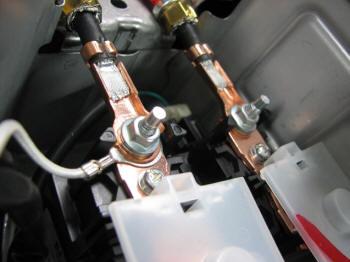 |
If you look closely you can see that the main relay studs on my 2006 are different than yours; my options for fastening additional fittings were a lot more limited. |
 |
|
| I used every bit of a 100' 12/3 lighted extension cord.
The male end is now sticking out of the R3000 XR, where it feeds the two
Cherokees modified per your specs. A bit more connects the Prius main
relay terminals to my new socket, and the rest stretches across our yard
and connects the other pieces. The neon pilot light in the female end is
convenient and quite happy with the Prius DC voltage.
I used a panel-mount Anderson PowerPak fitting as the socket in the car and their plug-type fitting to mate with it. A KLKD 20 amp DC-rated fuse protects the car from anything I might try to do to it. The socket and its enclosure sit quite unobtrusively in the driver-side rear cubby. (We do fold our seats down from time to time and preferred to keep the socket safely out of the way even when the seats are down.) |
|
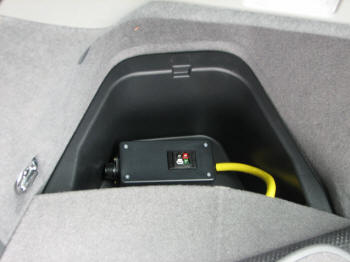 |
 |
| The transfer panel is a modified version of the cheap panels that sell every day on eBay. The stock 4-circuit panels are wired for 15 amp service, not quite enough. The stock 6-circuit panels use twist-lock connectors and would not allow me to distribute load across the R3000 XR's available load segments. I modified a 4-circuit panel by removing the convenience outlet, adding another 15-amp inlet, and splitting the device into a pair of electrically-independent 2-circuit panels. Each pair of circuits now has proper 15-amp wiring and is connected to a different load segment on the UPS. Interestingly, the factory panel was wired incorrectly -- each of the 4 load-side circuits has its own 15-amp breaker, but all of them were wired to draw though the breaker for the first circuit, effectively making the other three breakers irrelevant. | |
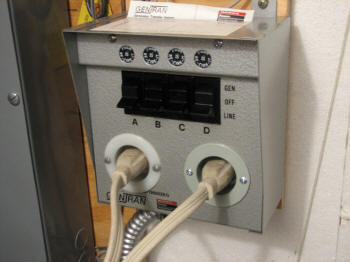 |
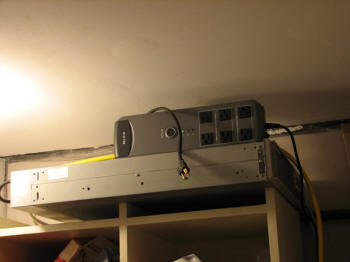 |
| Like you, I sacrificed the R3000 twist-lock connector
for ventilation. I added a wire cover for it and routed my DC input out
that way as well. I do use a pair of KLKD 15 amp fuses to protect the
Cherokees -- the little fuses they have internally would probably just
arc endlessly if they actually opened under DC load. I do have the
Cherokee's pushed up closer to their high limit -- my cheap DVM shows
102-104 volts.
The late addition of a pair of 800 μf caps connected to the external battery port did make a real difference in the ability of the UPS to handle peak loads (i.e., fridge compressor startup). One helped; two seem better. I may experiment with adding more. They're out of view on top of the main ups. The little Belkin UPS is there for more reliable cold starting of the R3000 XR. I added a dummy mail slot to our side door to admit the extension cord powering the UPS. Now all I need to do is write up instructions for my wife and wait for the power to fail! |
|
New 06 August 2006
